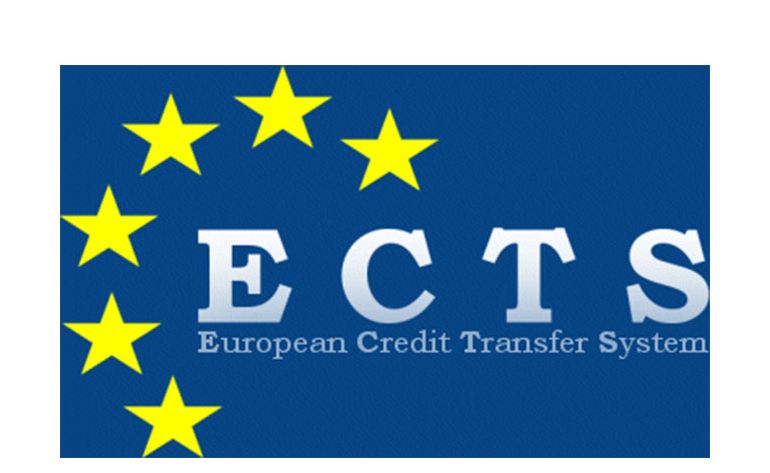
Evropa Kredit hujumchisi va yig'ish tizimi (ECTS) bir vositadir Evropa Oliy maydonida (UOTM) tadqiqotlar va kurslar yanada shaffof qilish va shu tariqa oliy ta'lim sifatini oshirish uchun yordam uchun.
ECTS 1989 yilda, Erasmus dasturi doirasida, talabalar chet elda o'qish davomida olgan kreditlarini o'z o'quv yurtlariga o'qishga qaytganlarida, o'z darajalariga kiradigan kreditlarga o'tkazish usuli sifatida tashkil etilgan. Keyingi yillarda u nafaqat o'quv yuklamalari va erishilgan o'quv natijalariga ko'ra , kreditlarni o'tkazish uchun , balki ularni institutlarning ilmiy dasturlarida to'plash uchun ham ishlatila boshlandi . ECTS dasturlarni ishlab chiqish, tavsiflash va etkazib berishda yordam beradi, har xil ta'lim turlarini umr bo'yi o'qish nuqtai nazaridan birlashtirishga imkon beradi va malakalarni tan olish jarayonini engillashtirib, o'quvchilarning harakatlanishini osonlashtiradi. va o'qish davrlari. ECTS barcha dasturlarga qo'llanilishi mumkin, qanday bo'lishidan qat'i nazar (sinfda, ishda, masofadan o'qitish) yoki talabalar maqomida (kunduzgi, sirtqi) va har xil ta'lim kontekstlarida (rasmiy, norasmiy va norasmiy).
ECTS Foydalanuvchilar uchun qo'llanma ECTSni qo'llash bo'yicha ko'rsatmalarni va foydali tasdiqlovchi hujjatlarga havolalarni taklif qiladi. Buxarestdagi Boloniya vazirlarining iltimosiga binoan (Buxarest kommyunikesi, 2012), EHEAda " ta'lim natijalarini mazmunli joriy etishni" kuchaytirish maqsadida 2009 yilgi ECTS foydalanuvchilar qo'llanmasi qayta ko'rib chiqildi . Qo'llanma vazirlarning maqsadini "institutlarni o'quv kreditlari bilan o'quv natijalari va o'quvchilarning yuklanishi bilan bog'lashga chaqirishga" chaqiradi. va baholash natijalariga ta'lim natijalariga erishishni kiritish. Bu qayta ko'rib chiqilgan versiya, Boloniya jarayonida ham, alohida mamlakatlarda ham akademik jamoaga va oliy ta'limning boshqa manfaatdor tomonlariga Boloniya jarayoni tomonidan ilgari surilgan o'zgarishlar yo'nalishi bo'yicha harakat qilishda yordam berish uchun so'nggi yillarda amalga oshirilgan ishlarning mustahkam poydevoriga asoslangan. .
Qayta ko'rib chiqilgan yo'riqnomada Boloniya jarayonidagi so'nggi o'zgarishlar, masalan, EHEAni tashkil etish, butun umrlik ta'limni mustahkamlash, o'qituvchi markazidan talabaga yo'naltirilgan oliy ta'limga o'tish, ta'lim natijalaridan foydalanishning ko'payishi va rivojlanish kabi masalalar hisobga olingan. o'qitish va o'qitishning yangi usullari. Bu dasturni ishlab chiqish va etkazib berishga alohida e'tiborni o'z ichiga oladi va oliy o'quv yurtlarining malaka tizimidan foydalanish va ECTS tamoyillarini akademik amaliyotda qo'llash tajribasiga asoslanadi.
Qo'llanma talabalar va boshqa o'quvchilarga , oliy o'quv yurtlarining akademik va ma'muriy xodimlariga, shuningdek ish beruvchilarga, ta'lim beruvchilarga va boshqa manfaatdor tomonlarga taklif qilinadi. O'qishni osonlashtirish uchun "talaba" atamasi oliy o'quv yurtlarining barcha talabalariga (kunduzgi yoki sirtqi bo'lsin, masofaviy, kampusda yoki ishda o'qish , malaka olish yoki keyingi stendda o'qish) qo'llaniladi. -yolg'iz o'quv bo'linmalari yoki kurslari).
Qayta ko'rib chiqilgan qo'llanma Boloniya mamlakatlari va manfaatdor tomonlar uyushmalari tomonidan tayinlangan amaliyotchilar ishchi guruhi tomonidan yozilgan. U manfaatdor tomonlar uyushmalariga, EHEA mamlakatlari ekspertlariga va Boloniya kuzatuv guruhiga maslahat uchun taqdim etilgan. Evropa Komissiyasi loyihani tayyorlash va maslahatlashuv jarayonini muvofiqlashtirdi. Nihoyat, Qo'llanma Evropa oliy ta'limi vazirlari tomonidan 2015 yilda Yerevan vazirlar konferentsiyasida qabul qilingan. Shuning uchun bu ECTSdan foydalanish bo'yicha rasmiy qo'llanma.
ecTS users-guide_en Yuklab olish